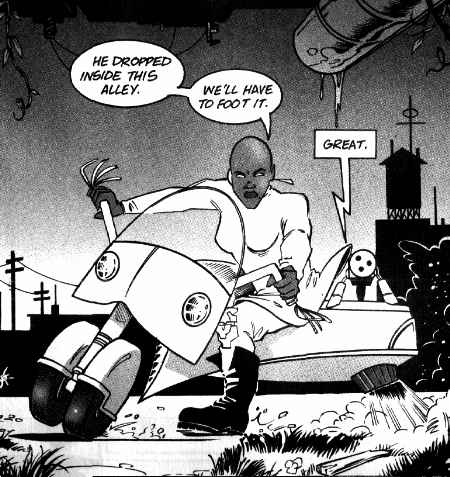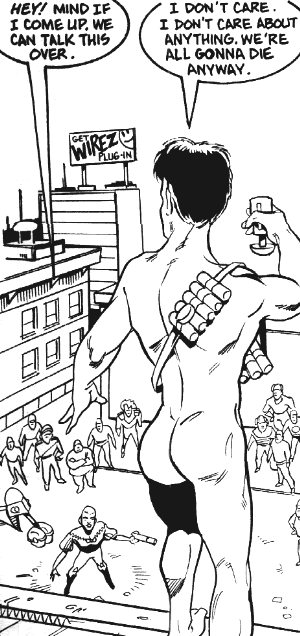CyberZone

 From looking at the letters he gets, Jimmie Robinson appears to have many people confused. Is the creator of CyberZone
From looking at the letters he gets, Jimmie Robinson appears to have many people confused. Is the creator of CyberZone
a woman or a man? Black or white? Straight or gay? How old? The confusion comes from the fact that the main characters are mostly women, more than a couple of them are lesbians, and the central character Amanda Shane is African-American. Robinson is not a bald young black lesbian, however. I don’t think his daughter is, either. But he does a credible job of writing one. Chalk it up to doing his homework… and caring about getting it “right”.
 CyberZone is set in 2031, in an America in which the police have been replaced with private bounty hunters called “superheroes”, computers and cybernetic technology have advanced, but society as we know it has continued on a downward spiral. Some zones are still nice and safe to raise a family. But not the CyberZone, where Amanda Shane works as a registered superhero, with the assistance of her self-aware weapon Gunn. Case in point: see what happens to Amanda’s lover Chela in the first three issues. It’s a bit… unusual.
CyberZone is set in 2031, in an America in which the police have been replaced with private bounty hunters called “superheroes”, computers and cybernetic technology have advanced, but society as we know it has continued on a downward spiral. Some zones are still nice and safe to raise a family. But not the CyberZone, where Amanda Shane works as a registered superhero, with the assistance of her self-aware weapon Gunn. Case in point: see what happens to Amanda’s lover Chela in the first three issues. It’s a bit… unusual.
This may sound like just more of the same grim-n-gritty anti-hero girl-with-a-gun crap you’ve seen from larger publishers. But this self-published series has a more personal, optimistic vision. In Robinson’s dystopia, some people still hold onto their humanity and their hope, even in this Brave New World of organ snatchers, mecha-mutts, and neuro-bots. Some even manage to find love.
One thing I’ve enjoyed while reading the series was watching the development… of the characters, the art, the storytelling, and Robinson’s overall “vision” of the book. The inside of the front cover of #1 begins, “Welcome to my world… What you’re holding is a pure solitary effort by me… Jimmie Robinson!” Working by himself, in between a “wage slave” job and single-parenthood, Robinson set out to bypass the publishers and do his own thing. Like many self-publishers, he discovered that doesn’t always work. But instead of handing the publishing
over to an established company to concentrate on the writing and drawing, Robinson chose to rearrange his work schedule (turning his day job into a night job) and bring in writing help, while he maintained overall control as editor/artist/letterer/publisher. Interesting.
 In the back of #3, Robinson includes a 6-page story featuring Amanda Shane that he did 3 years earlier, using a storyline he’d written 10 years earlier, using characters he’d created 22 years earlier. Bits of dialog, situations, and character designs are recognisable from the current series, but it’s not quite the same. For one thing, I’m glad Amanda has a more sensible costume now. And she looks, well, cooler without the hair.
In the back of #3, Robinson includes a 6-page story featuring Amanda Shane that he did 3 years earlier, using a storyline he’d written 10 years earlier, using characters he’d created 22 years earlier. Bits of dialog, situations, and character designs are recognisable from the current series, but it’s not quite the same. For one thing, I’m glad Amanda has a more sensible costume now. And she looks, well, cooler without the hair.
Robinson’s art is pretty darn good for a “debut” effort, but considering that he’s been “practicing” for this series most of his life, that’s not surprising. The most noticeable improvement over the course of this series is the addition of “toning” (the b&w equivalent of coloring). Not only does Amanda look more realistic with skin coloring, it adds more depth and subtlety to many of the scenes. (The image at the top of this review is from #4, with toning; the one to the left is from #1, without.) If he wanted to “sell out” and work for someone else as an artist, I can’t see any objective reason he couldn’t. (But then, whoever said that the criteria of the majors were objective?) But maybe he takes a little too much responsibility for his art: He apologised in print for the fact that Amanda’s shirt had four bows in #1, but only three in #2. (The three-bow design works better.) Chill… it’s OK.
Robinson’s still working some of the kinks out of his writing and his art. But he’s making good progress. (It’ll be interesting to see how well it works bringing in other people to handle the writing.) And he’s caught the attention (and approval) of some “big fish” in the “small pond” of alternative comics (e.g. Terry Moore, Roberta Gregory, Batton Lash, M’Oak, Howard Cruse, David Mack, Teri Woods). And as long as Robinson doesn’t leave me confused about the story, he’s got mine as well.
Robinson stopped producing CyberZone, due to the fact that it simply wasn’t paying for itself, and he couldn’t afford to publish at a loss. However, he has done a 4-issue series for Image Comics called Amanda and Gunn, starring… Amanda and Gunn… and an all-ages graphic novel about twin 12-year-old girls who become superheroes called Evil and Malice.
